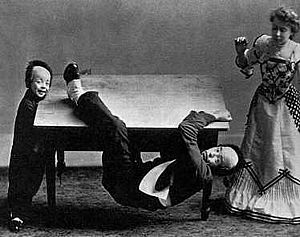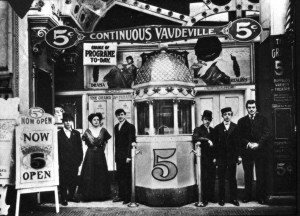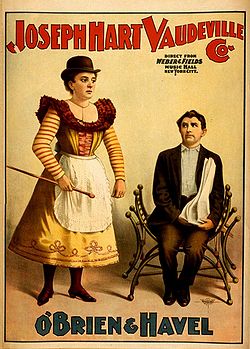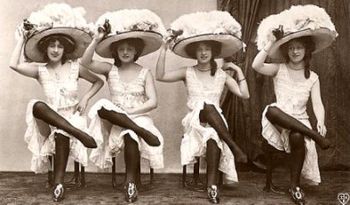Difference between revisions of "Vaudeville" - New World Encyclopedia
Serena Doose (talk | contribs) |
({{Contracted}}) |
||
| Line 1: | Line 1: | ||
| + | {{Contracted}} | ||
{{About|the American vaudeville|other uses|Vaudeville (disambiguation)}} | {{About|the American vaudeville|other uses|Vaudeville (disambiguation)}} | ||
Revision as of 15:25, 7 September 2007
- This article is about the American vaudeville. For other uses, see Vaudeville (disambiguation).
Vaudeville was a genre of variety entertainment prevalent in the United States and Canada from the early 1880s until the early 1930s. Developing from many sources, including concert saloons, minstrelsy, freak shows, dime museums, and literary burlesque, vaudeville became one of the most popular types of entertainment in North America. Each evening's bill of performance was made up of a series of separate, unrelated acts. Types of acts included (among others) musicians (both classical and popular), dancers, comedians, trained animals, magicians, female and male impersonators, acrobats, one-act plays or scenes from plays, athletes, lecturing celebrities, minstrels, and short films.
Etymology
[citation needed]The origin of the term is obscure, but is often explained as a corruption of the expression "voix de ville," or "voice of the city." Another plausible etymology makes it a corruption of the French Vau de Vire, a valley in Normandy noted for style of songs with topical themes. Though "vaudeville" had been used in the United States as early as the 1830s, most variety theatres adopted the term in the late 1880s and early 1890s for two reasons. First, seeking middle class patrons, they wished to distance themselves from the earlier rowdy, working-class variety halls. Second, the French or pseudo-French term lent an air of sophistication, and perhaps made the institution seem more consistent with the Progressive Era's interests in education and self-betterment. Some, however, preferred the earlier term to what manager Tony Pastor called its "sissy and Frenchified" successor. Thus one often finds records of vaudeville being marketed as "variety" well into the twentieth century.[citation needed]
Beginnings
A descendant of variety, (c. 1860s-1881), vaudeville distinguished itself from the earlier form by its mixed-gender audience, usually alcohol-free halls, and often slavish devotion to inculcating favor among members of the middle class. The form gradually evolved from the concert saloon and variety hall into its mature form throughout the 1870s and 1880s. This more genteel form was known as "Polite Vaudeville."
The true beginnings of vaudeville in America probably lie in New Orleans and the "medicine shows" that toured small towns throughout the country,giving small town America a glimpse into the music hall culture of Paris and Great Britain. In the years before the Civil war, entertainment existed on a different scale. Certainly, variety theatre existed before 1860. Europeans enjoyed types of variety performances years before anyone even had conceived of the United States. On American soil, as early as the first decades of the nineteenth century, theatre goers could enjoy a performance of Shakespeare, acrobats, singers, presentations of dance, and comedy all in the same evening. As the years progressed, seekers of diversified amusements found an increasing number to choose from. A handful of circuses regularly toured the country, dime-museums appealed to the curious, amusement parks, riverboats, and town halls often featured "cleaner" presentations of variety entertainment, while saloons, music-halls, and burlesque houses catered to those with a taste for the risqué. In the 1840's, minstrel shows, another type of variety performance, and "the first emanation of a pervasive and purely American mass culture," grew to enormous popularity and formed as Nick Tosches writes, "the heart of nineteenth-century show business." Medicine shows traveled the countryside offering programs of comedy, music, jugglers and other novelties along with their tonics, salves, and miracle elixirs, while Wild West Shows provided romantic vistas of the disappearing frontier complete with trick riding, music, and drama. Vaudeville incorporated these various itinerant amusements into a stable, institutionalized form centered in America's growing urban hubs.
Problematically, the term "vaudeville," itself, referring specifically to North American variety entertainment, came into common usage after 1871 with the formation of "Sargent's Great Vaudeville Company" of Louisville, Kentucky, and had little if anything to do with the "vaudeville" of the French theatre. Variety showman, M.B. Leavitt claimed the word originated from the French "vaux de ville" ("worth of the city, or worthy of the city's patronage"), but in all likelihood, as Albert McLean suggests, the name was merely selected "for its vagueness, its faint, but harmless exoticism, and perhaps its connotation of gentility."4Leavitt and Sargent's shows differed little from the coarser material presented in earlier itinerant entertainments, although their use of the term to provide a veneer of respectability points to an early effort to cater variety amusements to the growing middle class.
In the early 1880s, impresario Tony Pastor, a former ringmaster with the circus turned theatre manager, capitalized on middle class sensibilities and spending power when he began to feature "polite" variety programs in several of his New York City theatres. The usual date given for the "birth" of vaudeville is 24 October 1881, when Pastor famously staged the first bill of self-proclaimed "clean" vaudeville in New York City. Hoping to draw a potential audience from female and family-based shopping traffic uptown, Pastor barred the sale of liquor in his theatres, eliminated questionable material from his shows, and offered gifts of coal and hams to attendees. Pastor's experiment proved successful, and other managers soon followed suit.
Popularity
Performance bill for Temple Theatre, Detroit, December 1, 1902.
(The manager's comments, sent back to the circuit's central office weekly, follow each act's description. The bill illustrates the typical pattern of opening the show with a "dumb" act to allow patrons to find their seats, placing strong acts in second and penultimate positions, and leaving the weakest act for the end, to clear the house |
File:Kvopera.jpg Typical provincial venue on the circuit: "The Opera" in Kirksville, Missouri |
B.F. Keith took the next step starting in Boston, where he built an empire of theatres and brought vaudeville to the people of the United States as well as Canada. Later, E.F. Albee, adoptive grandfather of the Pulitzer Prize-winning playwright Edward Albee, managed the chain to its greatest success. Circuits such as those managed by Keith-Albee provided vaudeville's greatest economic innovation and the principal source of its industrial strength, enabling a chain of allied vaudeville houses that remedied the chaos of the single theatre booking system by contracting acts for regional and national engagement that could grow from a few weeks to two years.
Albee also gave national prominence to vaudeville's trumpeting of "polite" entertainment, a commitment to entertainment equally inoffensive to men, women, and children. Acts who violated this ethos (e.g., using the word "hell") were admonished and threatened with expulsion from the week's remaining performances or with the canceling of their contracts. In spite of such threats, performers routinely flouted this censorship, often to the delight of the very audience members whose sensibilities were supposedly endangered.
By the late 1890s, vaudeville had large circuits, small and/or large houses in almost every sizable location, standardized booking, broad pools of skilled acts, and a loyal national following. At its height, vaudeville played across multiple strata of economic class and auditorium size. The three most common levels were the “small time” (lower paying contracts for more frequent performances in rougher, often converted theatres), the “medium time” (moderate wages for two performances each day in purpose-built theatres) and the “big time” (possible remuneration of several thousand dollars per week in large, urban theatres largely patronized by the middle and upper-middle classes). As performers rose in renown and established regional and national followings, they worked their way into the less arduous working conditions and better pay of the big time. The capitol of the big time was New York City's Palace Theater (or just “The Palace” in the patois of vaudevillians), built by Martin Beck in 1913 and operated by Keith. Featuring a bill stocked with inventive novelty acts, national celebrities, and acknowledged masters of vaudeville performance (e.g., comedian and trick roper Will Rogers), the Palace provided what many vaudevillians would considered the apotheoses of already remarkable careers.
While the neighborhood character of vaudeville attendance had always promoted a tendency to tailor fare for specific audiences, mature vaudeville grew to feature houses and circuits specifically aimed at certain demographic groups. African American patrons, often segregated into the rear of the second gallery in white-oriented theatres, had their own smaller circuits, as did speakers of Italian and Yiddish. (For a brief discussion of Black vaudeville, see Theater Owners Booking Association.) White-oriented regional circuits, such as New England's "Peanut Circuit," also provided essential training grounds for new artists while allowing established acts to experiment with and polish new material. At its height, vaudeville was rivaled only by churches and public schools among the nation's premiere public gathering places.
Decline
There was no abrupt end to vaudeville, though the form was clearly staggering by the late 1920s. The continued growth of the lower-priced cinema in the early 1910s dealt the heaviest blow to vaudeville, just as the advent of free broadcast television was later to diminish the cultural and economic strength of the cinema. (Ironically, cinema was first regularly commercially presented in the United States in vaudeville halls). Lured by greater salaries and less arduous working conditions, many early film and old time radio performers, such as W. C. Fields, Buster Keaton, the Marx brothers, Edgar Bergen, Jack Benny and The Three Stooges, used the prominence they first gained in live variety performance to vault into new media. (In so doing, such performers often exhausted in a few moments of screen time the novelty of an act that might have kept them on tour for several years.)

Other vaudevillians who entered in vaudeville's decline, including The Three Stooges, Abbott and Costello, Kate Smith, Bob Hope, Judy Garland, Fred Astaire and Rose Marie used vaudeville as a launching pad for later careers, leaving live performance before they had ever risen to the meteoric height of national celebrity. By the late 1920s, almost no vaudeville bill failed to include a healthy selection of cinema. Earlier in the century, many vaudevillians, cognizant of the threat represented by cinema, held out hope that the silent nature of the "flickering shadow sweethearts" would preclude the usurpation of the paramount place in the public's affection. With the introduction of talking pictures in 1926, however, the burgeoning film studios removed what had remained, for many, the chief point in favor of live theatrical performance: spoken dialogue. Theatre owners discovered that rental costs of films—when held against the price of performers, newly unionized stagehands, booking fees, lighting, orchestra, etc.—vastly increased their profits. Performers tried hanging on for a time in combination shows (often referred to as "vaudefilm") in which, in an inverse of earlier vaudeville, live performances accompanied a cinema-centric performance. Inevitably, managers further trimmed costs by eliminating more of these comparatively costly live performances. Vaudeville also suffered in the rise of broadcast radio following the greater availability of inexpensive receiver sets later in the decade. Even the hardiest within the vaudeville industry realized the form was in decline; the perceptive understood the condition to be terminal.
The 1930s, with standardized film distribution and talking pictures, only confirmed the end of the genre. By 1930, the vast majority of theatres had been wired for sound and none of the major studios was producing silent pictures. For a time, the most luxurious theatres continued to offer live entertainment, but the majority of theatres were forced by the Great Depression to economize. The shift of New York City's Palace Theatre, vaudeville's center, to an exclusively cinema presentation on 16 November 1932 is considered the final death knell of the art of vaudeville. Like the attempts to tie its birth to Pastor's first clean bill, no single event may be accurately considered as anything more than reflective of its gradual withering. Some in the industry blamed cinema's drain of talent from the vaudeville circuits for the medium's demise. Others argued that vaudeville had allowed its performances to become too familiar to its famously loyal, now seemingly fickle audiences. Though talk of its resurrection was heard throughout the 1930s and after, the demise of the supporting apparatus of the circuits and the inescapably higher cost of live performance made any large scale renewal of vaudeville unrealistic.
Architecture
The most striking examples of Gilded Age theatre architecture invariably rose from the largess of big time vaudeville magnates. Though classic vaudeville reached a zenith of capitalization and sophistication in urban areas dominated by national chains and commodious theatres, small-time vaudeville included countless more intimate and locally-controlled houses. Small-time houses were often converted saloons, rough hewn theatres or multi-purpose halls, together catering to a wide range of clientèle, though many small towns had purpose-built theatres.
Legacy
Some of the most prominent vaudevillians continued the migration to cinema, though others found that the gifts that had so delighted live audiences did not translate well into different media. Some performers whose eclectic styles did not conform well to the greater intimacy of the screen, like Bert Lahr, fashioned careers out of combining live performance, radio and film roles. Many others later appeared in the Catskill resorts that constituted the "Borscht Belt." And many simply retired from performance and entered the workaday world of the middle class, that group that vaudeville, more than anything else, had helped to articulate and entertain.
Yet vaudeville, both in its methods and ruling aesthetic, did not simply perish but rather resounded throughout the succeeding media of film, radio and television. The screwball comedies of the 1930s, those reflections of the brief moment of cinematic equipoise between dialogue and physicality, reflect the more madcap comedic elements of some vaudeville acts (e.g., The Three Keatons). In form, the television variety show owed much to vaudeville, riding the multi-act format to success in shows such as "Your Show of Shows" with Sid Caesar and, of course, The Ed Sullivan Show. Even today, performers such as Bill Irwin, a Macarthur Fellow and Tony Award-winning actor, are frequently lauded as "New Vaudevillians."
References to vaudeville and the use of its distinctive argot continue throughout Western popular culture. Terms as “a flop” (an act that does badly), for example, have entered into accepted usage in the American idiom. Many of the most common performance techniques and "gags" of vaudeville entertainers are still seen on television and on film. Vaudeville, like its dime museum and variety theatre forebearers, also continued and solidified a strong American absorption with foreign entertainers.
Related forms
- Concert saloon
- Variety hall
- Chautauqua
- Revue
- Cabaret
- Burlesque
- Music hall
- "Borscht Belt"
- Nightclub
- Tom Shows
- 21st Century Vaudeville
New Vaudevillians
- The Quiddlers: Comedic Pantomime
- Michel Lauzière: Visual Comedy and Music
- Rudy Coby: Magician
- Stevie Star: Regurgitator
- Mr. Methane: Professional Flatulist
- Hope Talmon AKA Cyrelle St. James, House of Cherry co.: The one and only Red Headed song and dance in Las Vegas Nevada early 90's to the 2000 part of the neo burlesque and pin up swing era
- Daniel Nimmo: A one-man show, cabaret performer and theatre producer
- Vaudeville a la Mode: A 21st Century version of vaudeville using the internet started in 2007 hosted by local artists in Oakland, California
- Esther's Follies: Austin Texas vaudeville theater
- Voodoo Vaudeville: A vaudeville troupe based in Brighton, UK.
- Lucky the Painproof Man: Sideshow performer, black face, comedian, and singer. A one man vaudeville act.
ReferencesISBN links support NWE through referral fees
- Cullen, Frank, Florence Hackman, and Donald McNeilly. 2007. Vaudeville, Old & New: An Encyclopedia of Variety Performers in America. New York: Routledge. ISBN 0415938538
- Wertheim, Arthur Frank. 2006. Vaudeville Wars: how the Keith-Albee and Orpheum circuits controlled the big-time and its performers. Palgrave studies in theater and performance history. New York: Palgrave Macmillan. ISBN 1403968268
- Trav S. D. 2005. No applause, just throw money, or, The book that made vaudeville famous: a high-class, refined entertainment. New York: Faber and Faber. ISBN 0571211925
- DiMeglio, John E. 1973. Vaudeville U.S.A.. Bowling Green, Ohio: Bowling Green University Popular Press. ISBN 0879720530
- Slide, Anthony. 1994. The Encyclopedia of Vaudeville. Westport, Conn: Greenwood Press. ISBN 0313280274
- Stein, Charles W. 1984. American Vaudeville as seen by its Contemporaries. New York: Knopf. ISBN 0394537432
External links
- "Ventriloquists in the Later Vaudeville Years". Ventriloquist Central. Retrieved September 3, 2007.
- "Main Page". Legends of Vaudeville. Retrieved September 3, 2007.
- "Home Page". American Vaudeville Museum. Retrieved September 3, 2007.
- "Home Page". Virtual Vaudeville. Retrieved September 3, 2007.
- Keyser, Wayne N. 2005; "Glossary of Vaudeville Slang". Blue Ridge Entertainment. Retrieved September 3, 2007.
- "Listen to the Song "Will It Play In Peoria"". PeoriaRentals.com. Retrieved September 3, 2007.
- "J. Willis Sayre Photographs". University of Washington Libraries Digital Collections. Retrieved September 3, 2007.
- "Prior and Norris Troupe Photographs". University of Washington Libraries Digital Collections. Retrieved September 3, 2007.
- "19th Century Actors Photographs". University of Washington libraries Digital Collections. Retrieved September 3, 2007.
Credits
New World Encyclopedia writers and editors rewrote and completed the Wikipedia article in accordance with New World Encyclopedia standards. This article abides by terms of the Creative Commons CC-by-sa 3.0 License (CC-by-sa), which may be used and disseminated with proper attribution. Credit is due under the terms of this license that can reference both the New World Encyclopedia contributors and the selfless volunteer contributors of the Wikimedia Foundation. To cite this article click here for a list of acceptable citing formats.The history of earlier contributions by wikipedians is accessible to researchers here:
The history of this article since it was imported to New World Encyclopedia:
Note: Some restrictions may apply to use of individual images which are separately licensed.


